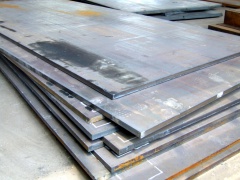Steel plates
| Infobox on Steel plates | |
|---|---|
| Example of Steel plates |  |
| Facts | |
| Origin | - |
| Stowage factor (in m3/t) | 0,48 m3/t (bundles) |
| Humidity / moisture | - |
| Ventilation | - |
| Risk factors | See text |
Steel plates
Description / Shipment / Storage
Sheet metal is metal by an industrial process into thin, flat pieces. It is one of the fundamental forms used in metalworking and it can be cut and bent into a variety of shapes. Countless everyday objects are constructed with sheet metal. Thicknesses can vary significantly, extremely thin thicknesses are considered foil or leaf, and pieces thicker than 6 mm (0.25 inch) are considered plate.
Sheet metal is available in flat pieces or coiled strips. The coils are formed by running a continuous sheet of metal through a roll slitter.
The thickness of sheet metal is commonly specified by a traditional, non-linear measure known as its gauge. The larger the gauge number, the thinner the metal. Commonly used steel sheet metal ranges from 30 gauge to about 8 gauge. Gauge differs between ferrous (iron based) metals and nonferrous metals such as aluminium or copper; copper thickness, for example is measured in ounces (and represents the thickness of 1 ounce of copper rolled out to an area of 1 square foot).
There are many different metals that can be made into sheet metal, such as aluminium, brass, copper, steel, tin, nickel and titanium. For decorative uses, important sheet metals include silver, gold and platinum (platinum sheet metal is also utilized as a catalyst).
Sheet metal is used for car bodies, airplane wings, medical tables, roofs for buildings (architecture) and many other applications. Sheet metal of iron and other materials with high magnetic permeability, also know as laminated steel cores, has applications in transformers and electric machines. Historically, an important use of sheet metal was in plate armor worn by cavalry, and sheet metal continues to have many decorative uses, including in horse tack.
Steel sheets are flat products with a rectangular cross-section, the width of which is much larger than the tickness. A distinction is drawn between hot- and cold-rolled sheet.
Hot-rolled sheet in sheets is produced from semifinished products (slabs or billets), which are reduced to certain thicknesses by rolling and annealling and cut mechanically or by burning into rectangular or also other shaped sheets.
Cold-rolled sheet in sheets is produced by removing rust from hot-rolled sheet by "pickling" it in a weak acid solution, then washing, brushing, drying, oiling and unrolling the sheet and finally performing cold-rolling by passing the sheet through a reducing mill and cutting into rectangular or also other shaped sheets. Cold-rolled steel is a more highly finished product and has a smoother surface, greater dimensional (thickness, width, length) and greater strength.
Mild hot rolled steel plates of various sizes are used extensively in tank construction, ship building and in the fabrication industry. The larges sizes are shipped in single pieces and in most instances stored outside, unprotected against the elements, prior to shipment. Therefore, they are generally loaded in a rusty condition. Stacks of these plates when viewed from the side often look wavy owing to wrong placing of dunnage. Prior to shipment the stacks are not under pressure, as they might be in the hold of a ship, so that the apparent deformations will probably only be temporary. Sometimes in handling, a plate will develop a transverse kink which must be considered as damage as the defect is permanent and will required a re-rolling operation to re-flatten it. In handling large plates special gear is required in the form of hooks coupled to chains.











